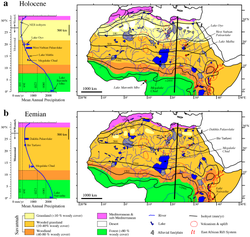Holocene

The Holocene is the present geological epoch. It started around 11,000 years ago after the last ice age. We are now in a relatively warm climate in Earth's history.
This is the second epoch of the Quaternary and the seventh of the Cainozoic.
Origin of name (or etymology)
Holocene comes from two Ancient Greek words.
The name was suggested by the French palaeontologist and entomologist Paul Gervais (d. 1879);[1][2] It is supposed to mean that the present time is part of the 'entirely new' epoch, or the "Holocene [epoch]".
Holocene climatic optimum
The Holocene climatic optimum (HCO) was a warm period from about 9,000 to 5,000 years BP. The interesting thing about this is, despite recent global warming, we are still below this warm period (see diagram).
The warm period was followed by a gradual decline until about two millennia ago.
More details
The Holocene is also called the Recent epoch. It is the second stage in the Quaternary period.
The Holocene marks the end of the previous series of ice ages in the Pleistocene. About 11,700 years ago the temperatures rose quickly from the previous level.
During the early Holocene, there were many extinctions amongst larger mammals. This is because of human hunting and climate change.[3][4][5]
At this time the Bering bridge connecting Russia and Alaska melted. Also the land bridge between China and Japan melted (starting the Jomon period), as well as many land bridges between islands in Southeast Asia.
Holocene Media
Vegetation and water bodies in northern and central Africa in the Eemian (bottom) and Holocene (top)
European coastline: modern (left), during the early Holocene (center) and during the Last Glacial Maximum (right)
A model of Çatalhöyük, a commonly cited example of a proto-city, 7300 BC
References
- ↑ "Origin and meaning of Holocene". Online Etymology Dictionary. Archived from the original on 2019-08-08. Retrieved 2019-08-08.
- ↑ "Origin and meaning of suffix -cene". Online Etymology Dictionary. Archived from the original on 2019-08-08. Retrieved 2019-08-08.
- ↑ Martin P.S. and Klein R.G. eds 1984. Quaternary extinctions: a prehistoric revolution. Arizona, Tucson AZ.
- ↑ Roberts, Neil 1998. The Holocene: an environmental history. 2nd ed, Blackwell, Malden, MA. ISBN 0-631-18637-9
- ↑ Mackay A.W. Battarbee R.W. Birks H.J.B. et al. eds 2003. Global change in the Holocene. Arnold, London. ISBN 0-340-76223-3



